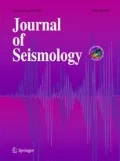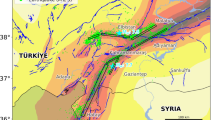Abstract
The German Regional Seismic Network (GRSN) comprizes now 16 digital broadband stations equipped with Wieland-Streckeisen STS-2 seismometers, 24-bit dataloggers and a seismological data center at Erlangen. It covers the whole territory of Germany with station-spacings between 80 km to 240 km. The stations are sited in very different environments ranging from near shore at the Baltic Sea coast up to distances of about 700 km from the coast, both within cities and up to about 10 km away from any major settlement, industry or traffic roads. The underground varies from outcropping hard rocks in Hercynian mountain areas, sedimentary rocks in areas of Mesozoic platform cover to up to 1.5 km unconsolidated Quarternary and Tertiary subsoil. Accordingly, seismic background noise varies in a wide range between the upper and lower bounds of the new global noise model. The noise conditions at the GRSN have been investigated systematically by means of displacement power spectral analysis within the frequency range 10-2 <f < 40 Hz. Smoothed power spectra have been calculated by applying the 'average segment method' using record intervals between 4 and 45 min long and between 6 and 25 overlapping segments. Representative samples were taken at different times of the day and the year in order to quantify for all sites the level and degree of variability of seismic background noise. The worst stations of the original GRSN were Berlin (BRLN), Hamburg (HAM) and Liddow (LID), all placed on unconsolidated soft-soil cover, between 50 m (at LID) and about 1.5 km thick (at HAM). But no spectral noise peaks due to wave resonance in this soft-soil cover could be identified because the noise spectra at all these sites are clearly dominated by strong ambient noise sources (traffic, industry and/or coastal surf sea-noise). For all three sites better locations had to be found at not too large distance from the original sites so as to preserve the good overall GRSN network configuration. Suitable alternatives were found at Rüdersdorf (RUE), Bad Segeberg (BSEG) and west of the village of Neunkirchen, Island of Rügen (RGN). RUE and BSEG were placed on locally outcropping sedimentary rock on top of a salt dome and within the cap of a diapir, respectively. The new station RGN was installed only 2.8 km away from the former LID in a huge soil-covered army bunker which provided much better thermal shielding and a more stable basement platform for long-period recordings. The noise power at RUE and BSEG as compared to BRLN and HAM is reduced by about 10 to 50 dB between 0.4 Hz <f < 50 Hz. This corresponds to 1 to 5 orders of magnitude in power spectral density or a factor of 3 to 300 in displacement amplitudes. For some selected, both near and teleseismic events improvements of the spectral signal-to-noise ratio > 5 for RUE and > 10 for BSEG have been confirmed for frequencies between about 0.6 Hz <f < 5 Hz. Thus BSEG has become now a station only somewhat inferior to the good hard rock sites in the central and southern part of Germany while RUE near Berlin is almost comparable with FUR near Munich. RGN, still being inappropriate in the teleseismic detection window around 1 s, is now almost as good as other fine GRSN stations in the long-period range between about 10 s <t < 50 s, comparable with FUR around f = 2 Hz and even better for f > 3 Hz. Strong lateral velocity and impedance contrasts between the outcropping Triassic/Permian sedimentary rocks and the surrounding unconsolidated Quarternary/Tertiary sediments are shown to be the main cause for the strong noise reduction and signal-to-noise ratio improvement at RUE and can account for about 50% of the noise reduction at BSEG.
Similar content being viewed by others
References
Ad Hoc Group of Scientific Experts to Consider International Cooperative Measures to Detect and Identify Seismic Events, 1991, Sourcebook for International Seismic Data Exchange. Conference Room Paper/167/Rev.2, Geneva, April 1991.
Baumbach, M., 1992, SEIS89 —a PC application for interactive seismogram analysis and processing. In: Applications of personal computers in seismology. XXII General Assembly of the European Seismological Commission. Servei Geològic de Catalunya, 9–12 and 112.
Beauduin, R., Lognonné, P., Montagner, J. P., Cacho, S., Karczewski, J. F. and Morand, M., 1996, The effects of the atmospheric pressure changes on seismic signals or how to improve the quality of a station. Bull. Seism. Soc. Am. 86, 1760–1769.
Bormann, P., 1997, Conversion and comparability of data presentations on seismic background noise. J. Seismology (submitted).
Deubel, K., Gaertner, H., Wolff, H. and Pröhl, S., 1996, Seismische Datenakquisition und Oberflächeneinfluß . In Teßmer, G. (ed.), Lithologieerkundung für den Tiefenaufschlußmit seismischen Methoden (ILITASEIS), Abschlußbericht Band 1, Hamburg, 5–54.
Fields, E. and Jacob, K., 1993, The theoretical response of sedimentary layers to ambient seismic noise. Geophys. Res. Letters 20, 2925–2928.
Friedrich, A., 1996, Untersuchung der breitbandigen seismischen Bodenunruhe an GRF-und GRSN-Stationen. Diploma Thesis, Department of Physics, University of Erlangen-Nürnberg.
Friedrich, A., Klinge, K. and Krüger, F., 1997, Ocean generated microseismic noise located with the Gräfenberg array. J. Seis mology (submitted).
Gurwitsch, I. I., 1970, Seismische Erkundung. Akademische Verlagsgesellschaft Geest &portig K.-G., Leipzig, 699 pp.
Henger, M. (Reporter), 1995, Abschlussbericht Breitbanderfassung seismischen Wellenfeldes im Bereich der Bundesrepublik Deutschland. Phase A: Errichtung und Betrieb der seismischen Stationen und des Datezentrums. DFG-Forschungsvorhaben Du 36/91,2 und Ba 1276/11, BGR Archiv Nr. 113 510.
Horst, W. and Küstermann, W., 1995, Ergebnisse reflexionsseismischer Messungen imBereich der Struktur Rüdersdorf. In: Schroeder, J.H. (ed.). Fortschritte in der Geologie von Rüdersdorf. Berliner Geowissenschaftliche Abhandlungen, Reihe A, Band 168, FU Berlin, 135–146.
Jubitz, B., 1993, Geologischer Rahmen: Überblick über die Struktur Rüdersdorf und deren Stellung im geologischen Umfeld Ostbrandenburgs. In Schroeder, J. H. (ed.), Führer zur Geologie von Berlin und Brandenburg. No. 1: Die Struktur Rüdersdorf. Selbstverlag Geowissenschaftler in Berlin and Brandenburg e.V., Berlin 1993, 14–36.
Konno, K., Ohmachi, T., Endoh, T. and Toshinawa, T., 1994, Refinement and application of an estimation procedure for site natural periods using microtremor (abstract), 27th Gen. Assem. of IASPEI, Wellington, New Zealand, 10- 21 January.
Lachet, C. and Bard, P.-Y., 1994, Numerical and theoretical investigations on the possibilities and limitations of the 'Nakamura's' technique. J. Physics of the Earth 42, 377–397.
Lermo, J. F., Francisco, S. and Chavez-Garcia, J., 1992, Site effect evaluation using microtremors: a review (abstract), EOS 73, 352.
Nakamura, Y., 1989, A method for dynamic characteristics estimation of subsurface using microtremor on the ground surface. Q. Rep. Railway Tech. Res. Inst., 30, 1.
Peterson, J., 1993, Observations and modeling of seismic background noise. U.S. Geol. Survey Open-File Report 93- 322, 95 pp.
Reinhardt, H. G., 1977, Regionale Geschwindigkeitsansätze der DDR. Report of the VEB Geophysik Leipzig.
Rogers, P. W., 1968, The response of the horizontal pendulum seismometer to Rayleigh and Love waves, tilt, and free oscillations of the Earth. Bull. Seism. Soc. Am. 58, 1384–1406.
Schroeder, J. H. (ed.), Führer zur Geologie von Berlin und Brandenburg. No. 1: DieStruktur Rüdersdorf. Selbstverlag Geowissenschaftler in Berlin and Brandenburg e.V., Berlin 1993, 14–36.
Wieland, E., 1990, Very-broad-band seismometry. In Boschi, E., Giardini, D. and Morelli, A. (eds), Proceed. 1st Workshop on MEDNET, Sept. 10- 14, 1990, CCSEM, Erice, IlCigno Galileo Galilei, Roma, 222–234
Wieland, E. and Zürn, W., 1991, Messungen der kurzperiodischen Bodenunruhe in Schiltach(BFO). In Henger (1995).
Rights and permissions
About this article
Cite this article
Bormann, P., Wylegalla, K. & Klinge, K. Analysis of broadband seismic noise at the German Regional Seismic Network and search for improved alternative station sites. Journal of Seismology 1, 357–381 (1997). https://doi.org/10.1023/A:1009754823719
Issue Date:
DOI: https://doi.org/10.1023/A:1009754823719




